The Analytics Of Things Market is estimated to be valued at USD 468.3 million in 2025 and is projected to reach USD 2065.7 million by 2035, registering a compound annual growth rate (CAGR) of 16.0% over the forecast period.
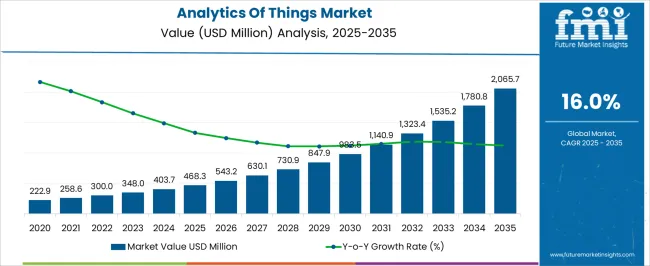
| Metric | Value |
|---|---|
| Analytics Of Things Market Estimated Value in (2025 E) | USD 468.3 million |
| Analytics Of Things Market Forecast Value in (2035 F) | USD 2065.7 million |
| Forecast CAGR (2025 to 2035) | 16.0% |
The Analytics of Things market is experiencing rapid growth, driven by the increasing deployment of connected devices and the demand for actionable insights from IoT-generated data across multiple sectors. Organizations are leveraging analytics platforms to improve operational efficiency, optimize resource utilization, and enable predictive maintenance.
The adoption of advanced AI, machine learning, and edge computing technologies has enhanced the capability to process and analyze large volumes of real-time data, supporting timely and informed decision-making. On-demand deployment models are gaining popularity due to their scalability, flexibility, and lower upfront costs, which allow businesses to integrate analytics solutions without extensive infrastructure investments.
Industries such as healthcare, manufacturing, and smart cities are increasingly relying on data-driven insights to improve performance and ensure compliance with regulatory standards As digital transformation initiatives expand and the IoT ecosystem grows, the Analytics of Things market is poised for sustained growth, with investments in integration, interoperability, and advanced analytics shaping the competitive landscape.
The analytics of things market is segmented by deployment type, service type, industry verticals, application type, and geographic regions. By deployment type, analytics of things market is divided into On-Demand and On-Premise. In terms of service type, analytics of things market is classified into Deployment And Integration, Support And Maintenance, Consulting Services, and Managed Services. Based on industry verticals, analytics of things market is segmented into Healthcare, Telecommunications & IT, Retail, Manufacturing, Government & Defense, Energy & Utilities, Transportation & Logistics, and Others. By application type, analytics of things market is segmented into Energy Management, Predictive Maintenance And Assets Management, Inventory Management, Security And Emergency Management, Sales And Customer Management, Building Automation, Infrastructure Management, Remote Monitoring, and Others. Regionally, the analytics of things industry is classified into North America, Latin America, Western Europe, Eastern Europe, Balkan & Baltic Countries, Russia & Belarus, Central Asia, East Asia, South Asia & Pacific, and the Middle East & Africa.
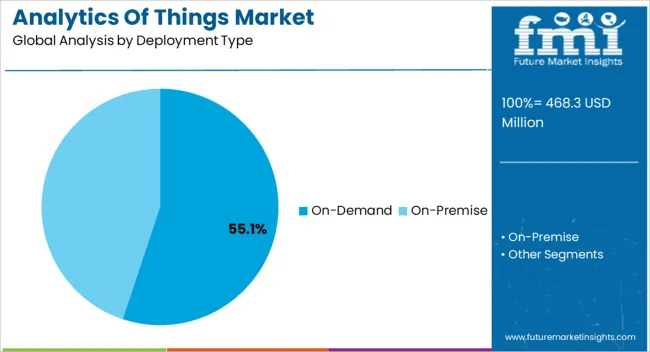
The on-demand deployment type segment is projected to hold 55.1% of the market revenue in 2025, making it the leading deployment model. Growth is driven by the flexibility and scalability offered by cloud-based platforms, which allow organizations to access analytics capabilities without significant capital expenditure or long-term infrastructure commitments. On-demand deployment supports rapid integration with existing IT and IoT systems, enabling faster implementation and real-time data analysis.
Businesses benefit from subscription-based models that reduce costs while providing the ability to scale resources according to demand. The segment’s leadership is further strengthened by the increasing adoption of edge computing and AI-enabled analytics, which enhance performance and decision-making capabilities.
Organizations across industries are leveraging on-demand solutions to gain insights into operational processes, customer behavior, and predictive maintenance, supporting improved efficiency, cost reduction, and competitiveness Continued advancements in cloud technologies and secure data access are expected to reinforce the dominance of the on-demand deployment segment.
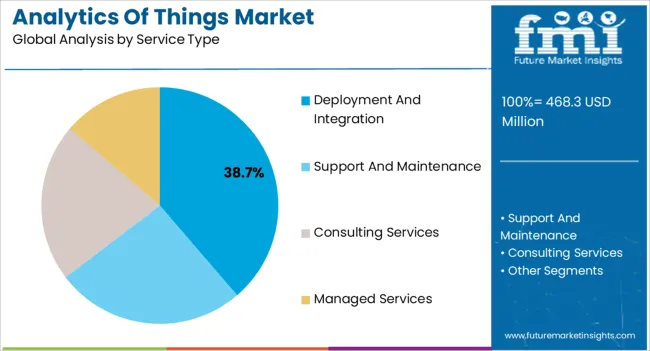
The deployment and integration service type segment is expected to account for 38.7% of the market revenue in 2025, making it the leading service category. Growth in this segment is being driven by the increasing need for seamless integration of analytics platforms with IoT devices, enterprise systems, and business workflows.
Service providers facilitate configuration, customization, and deployment to ensure that analytics solutions align with organizational objectives and deliver actionable insights. The availability of professional deployment and integration services reduces implementation complexity, minimizes downtime, and enhances operational efficiency.
Advanced analytics capabilities, coupled with AI-driven insights, allow businesses to optimize performance, improve predictive maintenance, and enhance decision-making processes As organizations continue to prioritize data-driven operations and seek end-to-end support for IoT analytics, the deployment and integration service segment is expected to remain a primary contributor to market growth, supported by technological advancements and increasing demand for streamlined implementation.
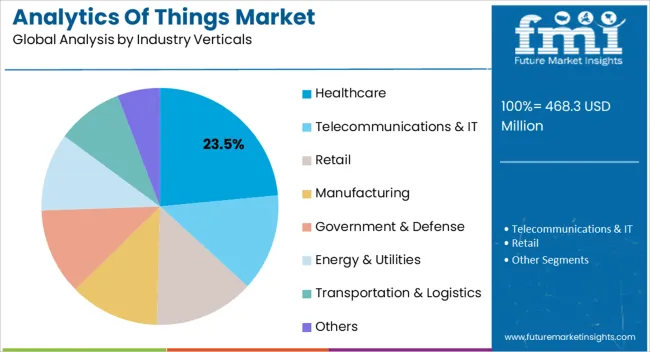
The healthcare vertical is projected to hold 23.5% of the market revenue in 2025, positioning it as the leading industry segment. Growth is being driven by the need for real-time patient monitoring, predictive analytics for treatment outcomes, and efficient management of healthcare operations.
Analytics of Things platforms enable healthcare providers to integrate data from medical devices, wearables, and hospital systems to deliver actionable insights for clinical decision-making. AI and machine learning applications allow early detection of health risks, optimization of resource allocation, and improved operational efficiency.
The segment benefits from rising healthcare investments, regulatory compliance mandates, and increasing adoption of smart medical devices As the focus on patient-centric care, telemedicine, and connected healthcare solutions grows, the healthcare vertical is expected to continue leading the Analytics of Things market, supported by demand for improved outcomes, operational cost reduction, and enhanced data-driven decision-making.
The current valuation of the Analytics of Things market in 2025 is US$ 300 billion and it is projected to grow at a modest CAGR of 16% during the forecast period to reach a market value of US$ 1323.43 billion by 2035.
| Attributes | Details |
|---|---|
| Market Valuation (2025) | US$ 300 billion |
| Market Valuation (2035) | US$ 1323.43 billion |
| CAGR | 16% |
Analytics of Things is the analysis of the data which is generated through internet of things devices. Moreover, analytics of things is vital to make the connected devices smart and to provide the devices the capability to make intelligent decisions. Also, analytics of things recommends that analytics are essential to derive connected devices smart and for them to make an intelligent exploit.
There are various groups of analytics of things, including analysis for variation and the understanding patterns, optimization by analysis of a procedure, predictive asset maintenance, and detection of anomalies, situational awareness and prescription. Analytics of things provide solutions to enterprises in confirming the devices connected to internet work more are smarter and efficiently.
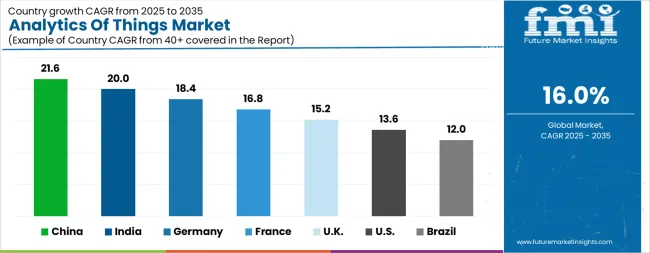
| Country | CAGR |
|---|---|
| China | 21.6% |
| India | 20.0% |
| Germany | 18.4% |
| France | 16.8% |
| UK | 15.2% |
| USA | 13.6% |
| Brazil | 12.0% |
The Analytics Of Things Market is expected to register a CAGR of 16.0% during the forecast period, exhibiting varied country level momentum. China leads with the highest CAGR of 21.6%, followed by India at 20.0%. Developed markets such as Germany, France, and the UK continue to expand steadily, while the USA is likely to grow at consistent rates. Brazil posts the lowest CAGR at 12.0%, yet still underscores a broadly positive trajectory for the global Analytics Of Things Market. In 2024, Germany held a dominant revenue in the Western Europe market and is expected to grow with a CAGR of 18.4%. The USA Analytics Of Things Market is estimated to be valued at USD 168.4 million in 2025 and is anticipated to reach a valuation of USD 602.9 million by 2035. Sales are projected to rise at a CAGR of 13.6% over the forecast period between 2025 and 2035. While Japan and South Korea markets are estimated to be valued at USD 25.1 million and USD 14.8 million respectively in 2025.
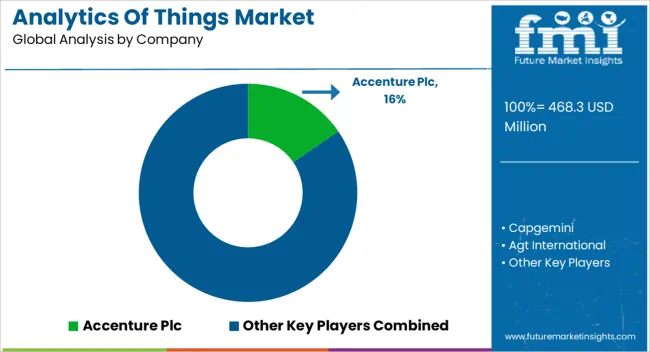
| Item | Value |
|---|---|
| Quantitative Units | USD 468.3 Million |
| Deployment Type | On-Demand and On-Premise |
| Service Type | Deployment And Integration, Support And Maintenance, Consulting Services, and Managed Services |
| Industry Verticals | Healthcare, Telecommunications & IT, Retail, Manufacturing, Government & Defense, Energy & Utilities, Transportation & Logistics, and Others |
| Application Type | Energy Management, Predictive Maintenance And Assets Management, Inventory Management, Security And Emergency Management, Sales And Customer Management, Building Automation, Infrastructure Management, Remote Monitoring, and Others |
| Regions Covered | North America, Europe, Asia-Pacific, Latin America, Middle East & Africa |
| Country Covered | United States, Canada, Germany, France, United Kingdom, China, Japan, India, Brazil, South Africa |
| Key Companies Profiled | Accenture Plc, Capgemini, Agt International, GE, Google, Inc., Cisco Systems, Inc., Intel Corporation, Hitachi Data System, International Business Machines Corporation, Microsoft Corporation, Oracle, PTC, Salesforce.Com, SAP SE, and Tibco Software, Inc. |
The global analytics of things market is estimated to be valued at USD 468.3 million in 2025.
The market size for the analytics of things market is projected to reach USD 2,065.7 million by 2035.
The analytics of things market is expected to grow at a 16.0% CAGR between 2025 and 2035.
The key product types in analytics of things market are on-demand and on-premise.
In terms of service type, deployment and integration segment to command 38.7% share in the analytics of things market in 2025.






Our Research Products

The "Full Research Suite" delivers actionable market intel, deep dives on markets or technologies, so clients act faster, cut risk, and unlock growth.

The Leaderboard benchmarks and ranks top vendors, classifying them as Established Leaders, Leading Challengers, or Disruptors & Challengers.

Locates where complements amplify value and substitutes erode it, forecasting net impact by horizon

We deliver granular, decision-grade intel: market sizing, 5-year forecasts, pricing, adoption, usage, revenue, and operational KPIs—plus competitor tracking, regulation, and value chains—across 60 countries broadly.

Spot the shifts before they hit your P&L. We track inflection points, adoption curves, pricing moves, and ecosystem plays to show where demand is heading, why it is changing, and what to do next across high-growth markets and disruptive tech

Real-time reads of user behavior. We track shifting priorities, perceptions of today’s and next-gen services, and provider experience, then pace how fast tech moves from trial to adoption, blending buyer, consumer, and channel inputs with social signals (#WhySwitch, #UX).

Partner with our analyst team to build a custom report designed around your business priorities. From analysing market trends to assessing competitors or crafting bespoke datasets, we tailor insights to your needs.
Supplier Intelligence
Discovery & Profiling
Capacity & Footprint
Performance & Risk
Compliance & Governance
Commercial Readiness
Who Supplies Whom
Scorecards & Shortlists
Playbooks & Docs
Category Intelligence
Definition & Scope
Demand & Use Cases
Cost Drivers
Market Structure
Supply Chain Map
Trade & Policy
Operating Norms
Deliverables
Buyer Intelligence
Account Basics
Spend & Scope
Procurement Model
Vendor Requirements
Terms & Policies
Entry Strategy
Pain Points & Triggers
Outputs
Pricing Analysis
Benchmarks
Trends
Should-Cost
Indexation
Landed Cost
Commercial Terms
Deliverables
Brand Analysis
Positioning & Value Prop
Share & Presence
Customer Evidence
Go-to-Market
Digital & Reputation
Compliance & Trust
KPIs & Gaps
Outputs
Full Research Suite comprises of:
Market outlook & trends analysis
Interviews & case studies
Strategic recommendations
Vendor profiles & capabilities analysis
5-year forecasts
8 regions and 60+ country-level data splits
Market segment data splits
12 months of continuous data updates
DELIVERED AS:
PDF EXCEL ONLINE
Analytics as a Service (AaaS) Market - Growth & Forecast 2025 to 2035
Analytics Sandbox Market
Ad Analytics Market Growth - Trends & Forecast 2025 to 2035
HR Analytics Market
AI-Powered Analytics – Transforming Business Intelligence
NFT Analytics Tools Market Size and Share Forecast Outlook 2025 to 2035
App Analytics Market Trends – Growth & Industry Forecast 2023-2033
Dark Analytics Market Size and Share Forecast Outlook 2025 to 2035
Text Analytics Market Size and Share Forecast Outlook 2025 to 2035
Cloud Analytics Market Size and Share Forecast Outlook 2025 to 2035
Drone Analytics Market Size and Share Forecast Outlook 2025 to 2035
Video Analytics Market Growth - Trends & Forecast 2025 to 2035
Visual Analytics Market Size and Share Forecast Outlook 2025 to 2035
Mobile Analytics Market Size and Share Forecast Outlook 2025 to 2035
Sports Analytics Market Growth - Trends & Forecast 2025 to 2035
Retail Analytics Market Analysis by Solution, Function, Enterprise Size, Deployment Model, Field Crowdsourcing, and Region Through 2035
Patent Analytics Market Trends – Growth & Industry Outlook 2024-2034
Speech Analytics Market
Content Analytics Discovery And Cognitive Systems Market Size and Share Forecast Outlook 2025 to 2035
Telecom Analytics Market Size and Share Forecast Outlook 2025 to 2035

Thank you!
You will receive an email from our Business Development Manager. Please be sure to check your SPAM/JUNK folder too.
Chat With
MaRIA